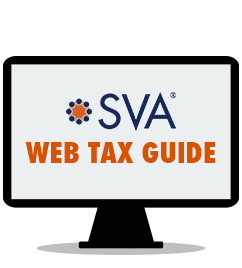Tax planning and strategizing should occur all year long, not just at year-end. We understand the many rules and regulations governing the tax landscape and can help you to determine the best solutions for your business.
Our tax team is knowledgeable about the numerous tax issues that face businesses and can help with business structuring, business tax planning, business tax credits, multistate/Nexus planning, and much more. Contact SVA today for all of your business tax needs.
We’ve compiled everything you need to know about the new tax law.
Business professionals need easy access to information to make timely decisions. SVA has what you need, when you need it. Choose a topic below or just contact us directly. Our expertise is ready anytime you need it.
The best way to stay current on all the ways your business can save time and money is to enlist an experienced accounting firm. SVA can help you with:
Tax planning should occur all year long, not just at year-end. SVA’s tax team is always in the know about the latest legislation and will help you minimize your business tax burden. Along with all the tax credits listed above, SVA can also help you with:
The tax-deferred exchange remains the most important tool in planning for non-personal real estate transactions. The 1031 exchange is a swap of one investment property for another, allowing capital gains to be deferred.
We work with clients to navigate the many rules and regulations that affect these transactions. We also will act on our clients’ behalf to arrange and act as a liaison between the various other professionals required to complete the transaction according to strict IRS rules.
BIZ TIP: Defer Capital Gains on Investment Properties With a 1031 Like-Kind Exchange
There are many tax credits currently available, along with new ones available each year based on stimulus legislation and changing presidential leadership. Here are a few SVA can help you with:
Nexus, also known as sufficient physical presence, determines whether an out-of-state business selling products into a state is liable for collecting sales and use tax on sales into the state. Nexus is required before a taxing jurisdiction can impose its taxes on an entity. Congress enacted Public Law 86-272 which protects companies with only minimal state activities from being taxed.
Our professionals can assist you in determining your company's multistate tax situation, take steps to insulate your activities from overzealous states, and minimize your overall state tax liability.
Everyone is familiar with sales tax and the role it plays as a consumer. However, understanding the complexities and laws involved with sales and use tax as it applies to business is another story.
Reduce the impact of sales tax on not only your business but your customers by proactively planning for the tax consequences of your business-related activities.
This eguide covers different tax credits and deductions available to businesses, as well as what to look for in a tax advisor, choosing a tax-advantaged business entity and more!

Visit SVA’s Web Tax Guide to access a wide array of resources that can help prepare you and your business for the upcoming tax season.
This eguide describes what depreciation is, the different types, how to calculate them, and answers common questions about depreciation.
Download the 2025 Federal Tax Rates PDF to get all the 2025 tax rates.
Services
Madison, WI
1221 John Q Hammons Dr, Suite 100
Madison, WI 53717
(608) 831-8181
Milwaukee, WI
18650 W. Corporate Drive, Suite 200
Brookfield, WI 53045
(262) 641-6888
Colorado Springs, CO
1880 Office Club Pointe, Suite 128
Colorado Springs, CO 80920
(719) 413-5551

Are you in the know on the latest business trends, tips, strategies, and tax implications? SVA’s Biz Tips are quick reads on timely information sent to you as soon as they are published.
Copyright © 2025 SVA Certified Public Accountants | Privacy Policy | Cookie Policy | CCPA